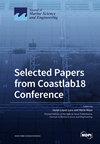有毒双鞭毛藻(双子叶植物纲)的休止囊肿广泛分布于中国整个沿海地区,在水华旺盛地区更为丰富
IF 2.8
3区 地球科学
Q1 ENGINEERING, MARINE
引用次数: 0
摘要
在中国不同地区偶尔会出现藻华,造成了巨大的经济损失,甚至威胁到人类健康。猫尾藻不仅是重要的有害藻华(HAB)致病菌种,也是目前已知的唯一能产生麻痹性贝类中毒毒素(PSTs)的藻类。由于静止孢囊的萌发通常会引发藻华,因此沉积物中孢囊的分布和丰度,特别是孢囊床的确认,是了解和预测甲藻藻华的重要信息。本研究从中国近海采集了 199 个沉积物样品,从渤海北戴河到南海南沙群岛的最南端。研究人员利用物种特异性引物和探针开发了 TaqMan 定量 PCR(qPCR)检测方法,以特异性地检测 199 个样本中包囊的分布和丰度。检测结果表明,囊尾蚴广泛存在于沉积物中(199 个样品中有 126 个样品),其中 93.55%、74.65%、42.37%和 50%的样品检测结果呈阳性,分别来自 BS、YS、ECS 和 SCS,覆盖了从南沙群岛到北戴河的广大海域。北戴河样品的单胞形态分子鉴定证实了BS海域存在卡地那藻包囊,并利用qPCR方法对卡地那藻包囊进行了阳性检测。虽然 G. catenatum 囊胞广泛分布于中国的四个海域,但平均丰度相对较低(每克湿沉积物 1.0 个囊胞)。然而,来自中国东海(ECS)的三个样本的卡氏囊虫含量(23个/克-1湿沉积物)相对高于其他海域,这表明囊虫丰度与近年来该海域频繁发生的卡氏囊虫藻华有关。总之,G. catenatum 是全球重要的有毒和致 HAB 物种,其孢囊在中国近岸海域无处不在的分布以及在水华易发区较高的丰度警示我们,尽管孢囊床目前丰度较低,但在未来任何一年都有可能在中国的任何海域和许多海域播下 HAB 种子,特别是那些过去有 HAB 频繁爆发记录的海域。本文章由计算机程序翻译,如有差异,请以英文原文为准。
Resting Cysts of the Toxic Dinoflagellate Gymnodinium catenatum (Dinophyceae) Ubiquitously Distribute along the Entire Coast of China, with Higher Abundance in Bloom-Prone Areas
Blooms of Gymnodinium catenatum have occurred occasionally in different areas of China and caused tremendous economic loss and even threatened human health. Not only is G. catenatum an important harmful-algal-bloom (HAB)-causing species, but also the only gymnodinioid dinoflagellate known to produce paralytic shellfish poisoning toxins (PSTs). Due to the germination of resting cysts, which often initiates blooms, the distribution and abundance of cysts in sediments and particularly the confirmation of cyst beds are important information for understanding and predicting dinoflagellate blooms. In this research, 199 sediment samples were collected from China’s coastal seas, ranging from the Beidaihe in the Bohai Sea (BS) to the southernmost sample from the Nansha Islands of the South China Sea (SCS). TaqMan quantitative PCR (qPCR) assays with species-specific primers and probes were developed to specifically detect the distribution and abundance of cysts in the 199 samples. The detection revealed that G. catenatum cysts were widely present in the sediments (126 of the 199 samples), with 93.55%, 74.65%, 42.37%, and 50% of the samples detected positively from the BS, YS, ECS and SCS, respectively, and covering the vast sea area from Nansha Islands to the Beidaihe area. The single-cyst morpho-molecular identification in the samples from Beidaihe confirmed the existence of G. catenatum cysts in the BS, and the positive detections of G. catenatum cysts using the qPCR methods. While G. catenatum cysts were widely distributed in all four seas of China, the average abundance was relatively low (1.0 cyst per gram of wet sediment). Three samples from the East China Sea (ECS), however, contained G. catenatum cysts at a relatively higher level (23 cysts g−1 wet sediment) than other sea areas, suggesting a pertinence of cyst abundance to the frequent occurrences of G. catenatum blooms in the area during recent years. Collectively, for G. catenatum being such an important toxic and HAB-causing species globally, the ubiquitous distribution of its cysts along the coastal waters of China and higher abundance in the bloom-prone areas warns us of a risk that cyst beds, although currently low in abundance, may seed HABs in any and many sea areas of China at any forthcoming year, and particularly those areas with records of frequent HABs outbreaks in the past.
求助全文
通过发布文献求助,成功后即可免费获取论文全文。
去求助
来源期刊

Journal of Marine Science and Engineering
Engineering-Ocean Engineering
CiteScore
4.40
自引率
20.70%
发文量
1640
审稿时长
18.09 days
期刊介绍:
Journal of Marine Science and Engineering (JMSE; ISSN 2077-1312) is an international, peer-reviewed open access journal which provides an advanced forum for studies related to marine science and engineering. It publishes reviews, research papers and communications. Our aim is to encourage scientists to publish their experimental and theoretical results in as much detail as possible. There is no restriction on the length of the papers. The full experimental details must be provided so that the results can be reproduced. Electronic files and software regarding the full details of the calculation or experimental procedure, if unable to be published in a normal way, can be deposited as supplementary electronic material.
 求助内容:
求助内容: 应助结果提醒方式:
应助结果提醒方式:


